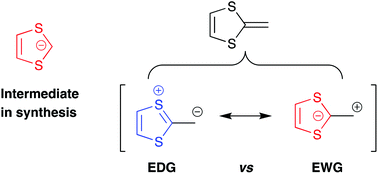The 1,3-dithiol-2-ide carbanion
Abstract
1,3-Dithiol-2-ide is a fully unsaturated five-membered heterocycle with a carbanion unit between two of the ring sulfur atoms. Derivatives thereof are important intermediates in synthetic protocols for preparing various 1,4-dithiafulvene (DTF) and tetrathiafulvalene (TTF) compounds by Wittig, Horner–Wadsworth–Emmons, or phosphite-mediated olefination reactions. When considering the electronic properties of DTF, one would usually consider this unit as an electron-donating group as it can form a 6π-aromatic 1,3-dithiolium ring by resonance. Yet, in this review, I will move forward a dual character of the DTF by which it can also act as an electron-withdrawing group, involving formation of the 1,3-dithiol-2-ide. In particular, this electronic effect can be used to explain its ability to promote the electrocyclic ring closure of a vinylheptafulvene into a dihydroazulene. This view on the properties of DTF is very much in line with the dual reactivity of ketene dithioacetals that react with both nucleophiles and electrophiles. Moreover, the 1,3-dithiol-2-ide unit was recently generated in the reduction of an extended and quinoid-like TTF where the core became an aromatic carbo-benzene moiety. This aspect is particularly interesting for future design of extended TTFs that can act as both electron donors and acceptors.

- This article is part of the themed collection: Mechanistic, computational & physical organic chemistry in OBC


 Please wait while we load your content...
Please wait while we load your content...